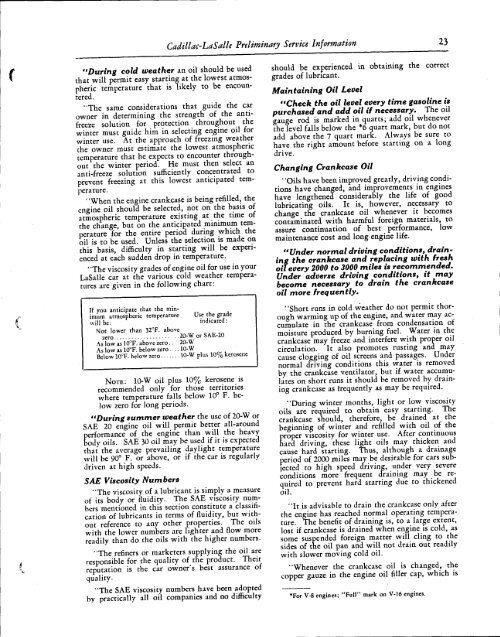1938 Cadillac V16 - GM Heritage Center
1938 Cadillac V16 - GM Heritage Center
1938 Cadillac V16 - GM Heritage Center
You also want an ePaper? Increase the reach of your titles
YUMPU automatically turns print PDFs into web optimized ePapers that Google loves.
<strong>Cadillac</strong>-LaSalle Preliminary Service Information 23<br />
"During cold weather an oil should be used<br />
that will permit easy starting at the lowest atmospheric<br />
temperature that is likely to be encountered.<br />
"The same considerations that guide the car<br />
owner in determining the strength of the antifreeze<br />
solution for protection throughout the<br />
winter must guide him in selecting engine oil for<br />
winter use. At the approach of freezing weather<br />
the owner must estimate the lowest atmospheric<br />
temperature that he expects to encounter throughout<br />
the winter period. He must then select an<br />
anti-freeze solution sufficiently concentrated to<br />
prevent freezing at this lowest anticipated temperature.<br />
"When the engine crankcase is being refilled, the<br />
engine oil should be selected, not on the basis of<br />
atmospheric temperature existing at the time of<br />
the change, but on the anticipated minimum temperature<br />
for the entire period during which the<br />
oil is to be used. Unless the selection is made on<br />
this basis, difficulty in starting will be experienced<br />
at each sudden drop in temperature.<br />
' 'The viscosity grades of engine oil for use in your<br />
LaSalle car at the various cold weather temperatures<br />
are given in the following chart:<br />
should be experienced in obtaining the correct<br />
grades of lubricant.<br />
Maintaining Oil Level<br />
"Check the oil level every time gasoline is<br />
purchased and add oil it necessary. The oil<br />
gauge rod is marked in quarts; add oil whenever<br />
the level falls below the *6 quart mark, but do not<br />
add above the 7 quart mark. Always be sure to<br />
have the right amount before starting on a long<br />
drive.<br />
Changing Crankcase Oil<br />
' 'Oils have been improved greatly, driving conditions<br />
have changed, and improvements in engines<br />
have lengthened considerably the life of good<br />
lubricating oils. It is, however, necessary to<br />
change the crankcase oil whenever it becomes<br />
contaminated with harmful foreign materials, to<br />
assure continuation of best performance, low<br />
maintenance cost and long engine life.<br />
"Under normal driving conditions, draining<br />
the crankcase and replacing with fresh<br />
oil every 2000 to 3000 miles is recommended.<br />
Under adverse driving conditions, it may<br />
become necessary to drain the crankcase<br />
oil more frequently.<br />
If you anticipate that the minimum<br />
atmospheric temperature Use the grade<br />
will be:<br />
indicated:<br />
Not lower than 32°F. above<br />
z e r o<br />
20-W or SAE-20<br />
As low as 10°F. above zero.. 20-W<br />
As low as 10°F. below zero... 10-W<br />
Below 10°F. below zero 10-W plus 10% kerosene<br />
NOTE: 10-W oil plus 10% kerosene is<br />
recommended only for those territories<br />
where temperature falls below 10° F. below<br />
zero for long periods.<br />
"During summer weather the use of 20-W or<br />
SAE 20 engine oil will permit better all-around<br />
performance of the engine than will the heavy<br />
body oils. SAE 30 oil may be used if it is expected<br />
that the average prevailing daylight temperature<br />
will be 90° F. or above, or if the car is regularly<br />
driven at high speeds.<br />
SAE Viscosity Numbers<br />
"The viscosity of a lubricant is simply a measure<br />
of its body or fluidity. The SAE viscosity numbers<br />
mentioned in this section constitute a classification<br />
of lubricants in terms of fluidity, but without<br />
reference to any other properties. The oils<br />
with the lower numbers are lighter and flow more<br />
readily than do the oils with the higher numbers.<br />
' 'The refiners or marketers supplying the oil are<br />
responsible for the quality of the product. Their<br />
reputation is the car owner's best assurance of<br />
quality.<br />
"The SAE viscosity numbers have been adopted<br />
by practically all oil companies and no difficulty<br />
"Short runs in cold weather do not permit thorough<br />
warming up of the engine, and water may accumulate<br />
in the crankcase from condensation of<br />
moisture produced by burning fuel. Water in the<br />
crankcase may freeze and interfere with proper oil<br />
circulation. It also promotes rusting and may<br />
cause clogging of oil screens and passages. Under<br />
normal driving conditions this water is removed<br />
by the crankcase ventilator, but if water accumulates<br />
on short runs it should be removed by draining<br />
crankcase as frequently as may be required.<br />
"During winter months, light or low viscosity<br />
oils are required to obtain easy starting. The<br />
crankcase should, therefore, be drained at the<br />
beginning of winter and refilled with oil of the<br />
Eroper viscosity for winter use. After continuous<br />
ard driving, these light oils may thicken and<br />
cause hard starting. Thus, although a drainage<br />
period of 2000 miles may be desirable for cars subjected<br />
to high speed driving, under very severe<br />
conditions more frequent draining may be required<br />
to prevent hard starting due to thickened<br />
oil.<br />
"It is advisable to drain the crankcase only after<br />
the engine has reached normal operating temperature.<br />
The benefit of draining is, to a large extent,<br />
lost if crankcase is drained when engine is cold, as<br />
some suspended foreign matter will cling to the<br />
sides of the oil pan and will not drain out readily<br />
with slower moving cold oil.<br />
"Whenever the crankcase oil is changed, the<br />
copper gauze in the engine oil filler cap, which is<br />
•For V-8 engines; "Full" mark on V-16 engines.
















